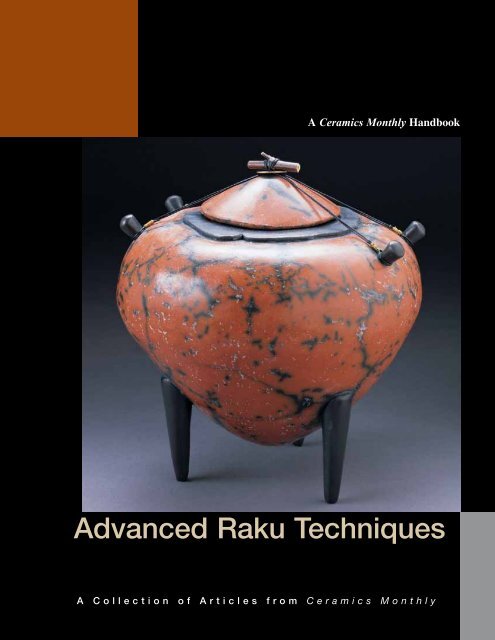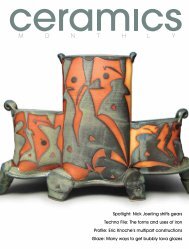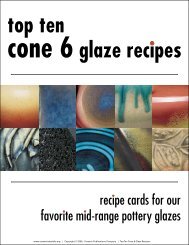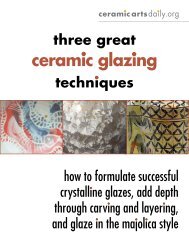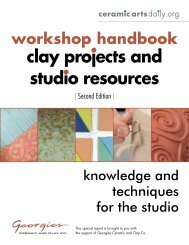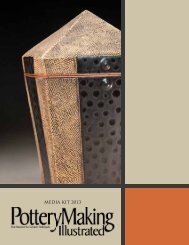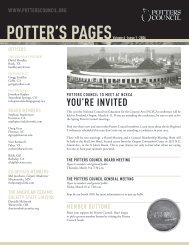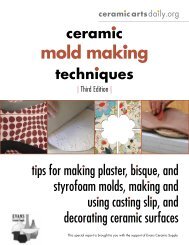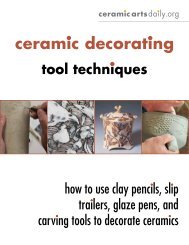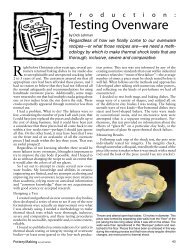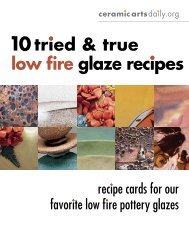Advanced Raku Techniques - Ceramic Arts Daily
Advanced Raku Techniques - Ceramic Arts Daily
Advanced Raku Techniques - Ceramic Arts Daily
You also want an ePaper? Increase the reach of your titles
YUMPU automatically turns print PDFs into web optimized ePapers that Google loves.
A <strong>Ceramic</strong>s Monthly Handbook<br />
<strong>Advanced</strong> <strong>Raku</strong> <strong>Techniques</strong><br />
A Collection of Articles from <strong>Ceramic</strong>s Monthly
<strong>Advanced</strong> <strong>Raku</strong> <strong>Techniques</strong>
<strong>Advanced</strong> <strong>Raku</strong> <strong>Techniques</strong><br />
A Collection of M a t e r i a l s from<br />
T h e A m e r i c a n C e r a m i c S o c i e t y<br />
Published by<br />
The American <strong>Ceramic</strong> Society<br />
600 N. Cleveland Ave., Suite 210<br />
Westerville, Ohio 43082 USA
The American <strong>Ceramic</strong> Society<br />
600 N. Cleveland Ave., Suite 210<br />
Westerville, OH 43082<br />
© 2004, 2011 by The American <strong>Ceramic</strong> Society, All rights reserved.<br />
ISBN: 1-57498-217-6 (Paperback)<br />
ISBN: 978-1-57498-564-1 (PDF)<br />
No part of this book may be reproduced, stored in a retrieval system or transmitted in any form or by any means, electronic,<br />
mechanical, photocopying, microfilming, recording or otherwise, without written permission from the publisher, except by a<br />
reviewer, who may quote brief passages in review.<br />
Authorization to photocopy for internal or personal use beyond the limits of Sections 107 and 108 of the U.S. Copyright<br />
Law is granted by The American <strong>Ceramic</strong> Society, provided that the appropriate fee is paid directly to the Copyright<br />
Clearance Center, Inc., 222 Rosewood Drive, Danvers, MA 01923 U.S.A., www.copyright.com. Prior to photocopying items<br />
for educational classroom use, please contact Copyright Clearance Center, Inc. This consent does not extend to copyright<br />
items for general distribution or for advertising or promotional purposes or to republishing items in whole or in part in any<br />
work in any format. Requests for special photocopying permission and reprint requests should be directed to Director,<br />
Publications, The American <strong>Ceramic</strong> Society, 600 N. Cleveland Ave., Westerville, Ohio 43082 USA.<br />
Every effort has been made to ensure that all the information in this book is accurate. Due to differing conditions,<br />
equipment, tools, and individual skills, the publisher cannot be responsible for any injuries, losses, and other damages that<br />
may result from the use of the information in this book. Final determination of the suitability of any information, procedure<br />
or product for use contemplated by any user, and the manner of that use, is the sole responsibility of the user. This book is<br />
intended for informational purposes only.<br />
The views, opinions and findings contained in this book are those of the author. The publishers, editors, reviewers and<br />
author assume no responsibility or liability for errors or any consequences arising from the use of the information contained<br />
herein. Registered names and trademarks, etc., used in this publication, even without specific indication thereof, are not to<br />
be considered unprotected by the law. Mention of trade names of commercial products does not constitute endorsement or<br />
recommendation for use by the publishers, editors or authors.<br />
Publisher: Charles Spahr, Executive Director, The American <strong>Ceramic</strong> Society<br />
Art Book Program Manager: Bill Jones<br />
Editor: Bill Jones<br />
Ebook Manager: Steve Hecker<br />
Graphic Design: Melissa Bury, Bury Design, Westerville, Ohio<br />
Graphic Production: Tess Speakman<br />
Cover Design: David Houghton, ACerS, and Melissa Bury<br />
Cover Image: “Red and Black Amphora” by Kristin Doner. Photo by James Patrick Dawson, Maximage
CONTENTS<br />
INTRODUCTION .............................................................................................1<br />
<strong>Raku</strong> Then and Now by Hal Riegger ....................................................................3<br />
Freedom to Discover by Will and Kate Jacobson ..................................................7<br />
Under a Bigger Sky: Montana’s Marcia Selsor by Louana Lackey .....................10<br />
<strong>Raku</strong> at Amatlan by Hilda San Vicente Tello ......................................................14<br />
Inlaid Glass Technique by Steven Branfman ......................................................16<br />
Gloss Crackle Glazing by John Ramer Sherrill ...................................................21<br />
Billy Ray Mangham by Gary C. Hatcher ...........................................................24<br />
CJ Buckner’s <strong>Raku</strong> Menagerie by Henry Atwater ..............................................28<br />
Tim Proud by Glen R. Brown ............................................................................30<br />
Floral Imagery on <strong>Raku</strong> Fans by Marcia Jestaedt ...............................................34<br />
George Whitten by Robert Hasselle ...................................................................36<br />
Karen Shapiro: The Art of Everyday Life by Lisa Crawford Watson ..................40<br />
Interior Vessels by Lori Neal...............................................................................44<br />
New Beginnings by Beth Cavener Stichter .........................................................46<br />
A Production <strong>Raku</strong> Kiln by Ronda M. Liskey ...................................................52<br />
Alternative <strong>Raku</strong> Kiln Designs by Andreas Salzman with Jennifer Salzman .......54<br />
A Wood-Firing <strong>Raku</strong> Kiln by Nesrin During .....................................................58<br />
Some Thoughts on <strong>Raku</strong> by Harold J. McWhinnie ...........................................62<br />
Designing a Matt Red <strong>Raku</strong> Glaze by Tom Buck ..............................................64<br />
Interference Colors with Copper <strong>Raku</strong> by R.W. Burrows .................................65<br />
Valdez Flashfiring by John Ramer Sherrill ..........................................................68<br />
Robert Sunday by Virginia Hillhouse .................................................................71<br />
Glaze Trials at Cone 08 by Lila Bakke ................................................................76<br />
Ramon Camarillo: Hawaiian Artist Goes East by Cathy Grubman ..................78<br />
Heroic <strong>Raku</strong> by Carl Gillberg .............................................................................82<br />
Steve Hemingway by Ralph O. Robinson ..........................................................86<br />
In Pursuit of Form by Kristin Doner..................................................................90<br />
<strong>Raku</strong> Potter Charles Bohn by Linda Bynum .....................................................94<br />
iv
Neoclassical <strong>Raku</strong> by Robert Hasselle ................................................................98<br />
<strong>Raku</strong> Sculpture by Pamela Earnshaw Kelly ......................................................100<br />
<strong>Raku</strong> Reduction Stenciling by Jerry L. Caplan ................................................104<br />
The Nichrome Solution by Cori Pinassi ...........................................................106<br />
Geyser Bottle Performance <strong>Raku</strong> by Jerry Crimmins ......................................108<br />
Building a Portable Gas Kiln<br />
by George Juliano with Elizabeth Hudgins ...............................................110<br />
Peel-Away Slip in a Hurry by Mark S. Richardson ...........................................113<br />
Traveling Solo by Peter Powning ......................................................................116<br />
Substitutions for Gerstley Borate by Jeff Zamek .............................................122<br />
QUESTIONS & ANSWERS ..........................................................................125<br />
SUGGESTIONS .............................................................................................133<br />
v
IntroductIon<br />
<strong>Raku</strong> is probably one of the most popular processes in ceramics due mainly to its<br />
simple straightforward process from ball-of-clay to finished glazed ware. And while<br />
raku is simple enough for potters of all skill levels to achieve a modicum of success,<br />
it’s the technically skilled and creative artists that have elevated this process to new<br />
heights. <strong>Raku</strong> to them is a vehicle that allows the flexibility to explore and experiment,<br />
and in doing so, take the medium to an inspiring level.<br />
This handbook contains over forty articles previously published in <strong>Ceramic</strong>s Monthly<br />
and Pottery Making Illustrated reflecting the skill and imagination of some of the best<br />
raku artists. You’ll find information on forming, finishing, and firing techniques,<br />
as well as recipes and stories of the journeys and personal experiences some of these<br />
artists have made. Additionally, we have included raku-related information from the<br />
“Questions & Answers” and “Suggestions” columns that have appeared in CM over<br />
the years.<br />
1 AdvAnced RAku <strong>Techniques</strong>
AdvAnced RAku <strong>Techniques</strong> 2
In the spring of 1948, I thought<br />
it would be fun to invite a few<br />
friends over, have a potluck supper<br />
outdoors and try this raku thing.<br />
Aside from Bernard Leach’s description<br />
and drawings of raku kilns and<br />
pots in A Potter’s Book, the only<br />
mention of raku I might have seen<br />
was in The American <strong>Ceramic</strong> Society<br />
Bulletin’s February 1943 issue.<br />
At the beginning of Warren Gilbertson’s<br />
report on “Making of <strong>Raku</strong><br />
Ware and Its Value in the Teaching<br />
of Beginners’ Pottery in America,”<br />
he mentions (almost casually) that<br />
raku’s major use in the Orient was<br />
for the tea ceremony. If either of<br />
these sources was where I first heard<br />
about raku, I cannot remember.<br />
Regardless, I certainly didn’t read carefully,<br />
or forgot some of what I read.<br />
The weather was perfect for that<br />
first raku firing. I lived in the country,<br />
partway up Mt. Tamalpais in Marin<br />
County, just north of San Francisco.<br />
Each of my guests made a couple of<br />
teabowls, and while they were drying,<br />
we had a fine supper with good<br />
California wine, then got down to the<br />
business of finishing the bowls. They<br />
were glazed raw, then dried again. I’d<br />
made a small electric kiln and put it<br />
outdoors. I don’t remember if I was<br />
first or if one of the guests took the<br />
initiative, but a bowl was put into the<br />
red-hot kiln and the lid replaced. In<br />
about a minute, there was a muffled<br />
sort of “poof” sound. We knew what<br />
had happened.<br />
<strong>Raku</strong> Then and Now<br />
by Hal Riegger<br />
American raku pioneer Hal Riegger removing<br />
a plate from the kiln for postfiring reduction.<br />
I turned off the kiln, and cleaned it<br />
out with the vacuum cleaner. A second<br />
pot was then put into the kiln, which<br />
had by then been turned on but was<br />
not yet red hot. It took about three<br />
minutes before that telltale muffled<br />
“poof” again.<br />
“Well, that’s it!” I thought. “Those<br />
Japanese don’t know what they’re talking<br />
about. The heck with raku.”<br />
But I didn’t want to give up. Alone,<br />
over breakfast the next morning, I reread<br />
Gilbertson’s article, and there on<br />
the very first page, he clearly describes<br />
the “biscuit” firing. Maybe the Japanese<br />
were okay after all.<br />
More slowly, more carefully, I gave<br />
it another try, this time using several<br />
little bisqued bowls. Although I had<br />
wished for someone to share my excitement,<br />
I was alone with my first success:<br />
a pinched teabowl, foot turned on<br />
the wheel; the glaze was a pale turquoise<br />
with a pink glow inside, and<br />
the foot was black.<br />
Before I had an opportunity to do<br />
much more raku, a change in jobs<br />
took me to Kansas as a designer for<br />
a small pottery manufacturer; on<br />
return to California, I taught at<br />
the College of <strong>Arts</strong> and Crafts in<br />
Oakland. But in 1958, the first time<br />
I taught at Haystack, raku was the<br />
subject. Those weeks marked the<br />
beginning of my serious involvement<br />
with the process.<br />
Two years earlier, at the first<br />
American Craftsman’s Council convention<br />
at Asilomar, near Carmel,<br />
California, I had met a Japanese<br />
potter who had done raku. Of course<br />
I quizzed him about all the aspects of<br />
raku that I wanted to know. I remember<br />
him making a crude little sketch<br />
of a raku kiln on a tiny yellow piece<br />
of paper. I wish I still had that sketch.<br />
Although we didn’t follow it exactly,<br />
it formed the basis of the kiln we used<br />
at Haystack.<br />
During three years of teaching in<br />
Florida, from 1958 through 1961,<br />
I did some more raku and primitive<br />
firings (what people now call “pit”<br />
firing). A year after returning from<br />
Florida to California, I started what I<br />
called Experiment A workshops (the<br />
title has absolutely no meaning whatsoever).<br />
These were week-long workshops<br />
“in the field,” where we would<br />
find our clay, make and fire pots, all in<br />
3 AdvAnced RAku <strong>Techniques</strong>
<strong>Raku</strong> plate, approximately 9 inches in length, with poured and brushed glaze decoration.<br />
Pinched teabowl, approximately 4 inches<br />
in height, raku fired.<br />
AdvAnced RAku <strong>Techniques</strong> 4<br />
<strong>Raku</strong> teabowl, approximately 4 inches in<br />
height, pinched, partially brushed with glaze.
a very primitive environment. Some of<br />
these workshops also dealt with raku<br />
fired in wood-burning kilns.<br />
These workshops were held over a<br />
period of 17 years in various places<br />
around the country, such as the beach<br />
at Mendocino, Panamint Valley in the<br />
Mojave area, a ghost town in Wyoming<br />
and at Cripple Creek in Colorado.<br />
Attendees for the primitive pottery<br />
workshops were allowed to bring only<br />
a shovel and bucket. Other tools had<br />
to be found objects.<br />
At first it was hard for us to get<br />
totally away from the studio when it<br />
came to kilns. Here, we used firebrick<br />
and shelves, until one occasion when<br />
none were available; it was then that a<br />
real breakthrough occurred. An entire<br />
wood-burning, top-loading kiln was<br />
made from a mixture of clay, sandy<br />
gravel and sawdust in more or less<br />
equal proportions. We also discovered<br />
that a fire could be lit in the wet kiln<br />
to dry it out and the mixture wouldn’t<br />
explode. Although slower than subse-<br />
A wood-fired raku kiln built from a mixture of fireclay, sandy gravel<br />
and sawdust at a British Columbia workshop.<br />
quent firings, the first firing took place<br />
the day after the clay/gravel/sawdust<br />
kiln was built. Some of the kilns the<br />
students built became almost human<br />
sculptures with breasts and buttocks.<br />
At any rate, by 1964, we had<br />
moved a step further from the limiting<br />
influence of studio equipment<br />
and routine processes into situations<br />
demanding creative thought and inventiveness<br />
arising from the situation.<br />
And, for raku, this was all to the good.<br />
As any potter is wont, when presented<br />
with a new tool, material or<br />
technique, the workshop participants<br />
would go all out and try all possible<br />
variations. In retrospect, some of the<br />
objects produced may not be quite<br />
appropriate in the traditional raku<br />
context, but we did explore and we<br />
did have fun.<br />
I’m at a loss to explain why or even<br />
when I did it myself, but one of the<br />
things not traditional among raku<br />
potters in Japan that is common<br />
among Western potters is a technique<br />
called “postfiring reduction.” In other<br />
words, the pot is put into a reducing<br />
atmosphere as it comes out of the glaze<br />
firing. This is usually done by placing<br />
the pot(s) hot from the kiln into easily<br />
combustible materials in a garbage can<br />
and covering with the lid.<br />
Somewhere along the line, I chose a<br />
different way that I like better: A small<br />
amount of sawdust is sprinkled on the<br />
ground to receive the hot raku object.<br />
A flat object (a plate perhaps) is just<br />
laid on the sawdust, and after a short<br />
interval, more sawdust is sprinkled on<br />
top of it. If rakuing a hollow form,<br />
such as a teabowl, I wave it in the air<br />
a few seconds, place it on the sawdust<br />
and push sawdust up to the rim on the<br />
outside only. After perhaps a minute,<br />
more sawdust is sprinkled on, burying<br />
the whole object. This wait is necessary,<br />
as the inside glaze cools more<br />
slowly and must solidify or sawdust<br />
will mar its surface.<br />
Western postreduction techniques<br />
may well have arisen from a misun-<br />
5 AdvAnced RAku <strong>Techniques</strong>
derstanding of the traditional Japanese<br />
reduction, which was done after the<br />
bisque and before glazing. Usually<br />
made of a very rough white clay, the<br />
bisque-fired teabowls were brushed<br />
with ocher, then placed in a fireclay<br />
box along with charcoal, which was<br />
then ignited. The whole process is a<br />
bit more detailed than what I have<br />
written here, but is well described and<br />
illustrated in Herb Sanders’ book The<br />
World of Japanese <strong>Ceramic</strong>s.<br />
After I quit having the workshops,<br />
I began to look at where I was with<br />
raku, what I was doing, how integral<br />
the process was to the result. In other<br />
words, were the things I was doing<br />
possible only with the raku process,<br />
or could they be made using any of<br />
a number of other methods available<br />
to potters?<br />
To me, this is the key. It’s not a matter<br />
of what materials one works with,<br />
what temperature one works at, or<br />
whether the firing is done with electricity,<br />
gas or wood, but whether the<br />
object is one that could only be made<br />
with the raku process.<br />
If I wanted to go further, following<br />
the more traditional ways that tie in<br />
with Zen philosophy, I could ask of<br />
this work whether it has the qualities<br />
that are so important to adherents of<br />
the tea ceremony. While most raku<br />
potters in America do not assess their<br />
pots in the same manner as a Japanese<br />
Zen master, there are aspects of a good<br />
ceremonial teabowl that can apply and<br />
are indeed valuable for the Western<br />
potter to understand and assimilate.<br />
The traditional raku teabowl is<br />
handmade from a rough, gritty clay,<br />
yet when completed, is pleasant to the<br />
touch. A summer teabowl is shallow<br />
and wide, while a winter teabowl is<br />
taller and narrower. For its size, it is<br />
<strong>Raku</strong> plate, approximately 9 inches in length, sandy red clay, with clear glaze, borax<br />
solution and trailed white glaze, by Hal Riegger.<br />
AdvAnced RAku <strong>Techniques</strong> 6<br />
thick but not heavy. It is asymmetrical;<br />
the rim undulates. There is a front and<br />
a back. The base rim (foot) must be so<br />
shaped that the bowl is easily picked<br />
up by the thumb and two fingers. The<br />
bottom inside must have a depression<br />
called a cha damari, or tea pool, where<br />
the last few drops of tea will look like<br />
rain collecting in a depressed rock (the<br />
potter consciously puts the cha damari<br />
there, yet it is supposed to look like<br />
it just sort of happened). The bowl<br />
must be larger at the lower belly to allow<br />
room for the whisk. And, finally,<br />
the inside must appear larger than the<br />
outside!<br />
Once, when discussing these aspects<br />
with a Japanese raku potter, I<br />
remarked, “You know, is this rationalizing?<br />
I wonder if this isn’t all a lot of<br />
hog wash.”<br />
To which he replied, “Now you’re<br />
getting into Zen.” ▲


